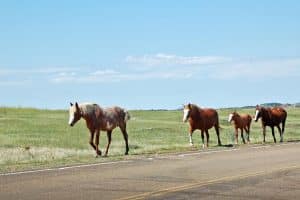ADS

[Photo: Sierra Schmidt]
Sierra Schmidt grew up visiting and getting to know the wild horses of Theodore Roosevelt National Park (TRNP). She says the memory is still in her mind as clear as the day she first saw ‘Cloud’ and his band walking down the road near the prairie dog town in the park. She was ten and had been coming to the park since she was three to see the horses. Cloud was an amazing stallion with a big white face and patches of white along his sides that looked like the puffy clouds he was named for. She remembers the horses walking single file with the young one between them to protect their newest member and how this touched her. Every trip to the park after that, she would look for Cloud.
“The horses of TRNP have helped to shape and mold me into the young adult that I am today,” said Schmidt.
Her interest in the horses has not waned, and she continues to advocate on their behalf. She currently serves on the board of North Dakota Badlands Horse. Sadly, Sierra and others who love the horses and see in them a beautiful heritage that should be protected are in a David vs. Goliath type of battle with the National Park Service (NPS).
President Theodore Roosevelt wrote of his encounters with the wild horses during his time in the Badlands. They were a common sight in those years that immeasurably shaped the man who would one day be president.
The efforts to find a way to honor Roosevelt began soon after his death in 1919. In 1949, Theodore Roosevelt National Memorial Park was dedicated. The original mission was to preserve Roosevelt’s ranching legacy. The wild horses that Roosevelt encountered and wrote about were an integral part of this. He played a role in bringing some of the park’s horses’ ancestors to the area. In 1885, he brought sixty wild horses from Frederick Remington’s ranch in Montana to his North Dakota Badlands ranch, the Maltese Cross.
There is evidence, as well, that some TRNP horses can be traced back to ones surrendered by Sitting Bull in 1881. A small herd of longhorns in the North Unit has also been a part of the park’s historic mission: “To reflect the living landscape as Roosevelt experienced it,” according to the Park Service. From its very beginning, wild horses were present in the park. In 1970, the horses were recognized as part of the historical setting, and policies were put in place to manage the horses as part of a historical demonstration herd. In 1978, the park became part of the NPS and natural resources began to be emphasized more when the mission was changed to preserving native species and habitat. However, since then the park has managed to preserve both native and historical species protecting an important American legacy.
[Photo: Sierra Schmidt]
In recent years something changed, and the NPS is now proposing to remove the horses altogether.
“The park was established to pay tribute to the conservation legacy of Theodore Roosevelt, and that legacy is defined by a natural ecosystem, which includes the native animal species, such as bison, elk, pronghorn, and the native grassland ecology,” Angie Richman, TRNP superintendent told National Parks Traveler. “The park is embarking on this plan now, so that we can address the non-native horses and cattle herds in the park so that we can better conserve those native aspects of the park.” However, she also acknowledged that they can’t definitively show the horses are having a damaging impact.
Wild horses roamed the Great Plains in vast herds, sometimes in the thousands, for more than 200 years from the 1600s to the mid-1800s. By 1850 it is estimated there were more than one million wild horses ranging across western lands. TRNP is one of the few national parks where visitors can experience the thrill of seeing a truly wild horse. The wild horses have lived peacefully and coexisted with the other animals in the park for more than seventy years. They have brought excitement and joy to every visitor that is lucky enough to spot them. The horses have also preserved unique genetic lines and provided research and educational opportunities. A study done in 2018, “Genetic Diversity and Origin of the Feral Horses in Theodore Roosevelt National Park,” found that the TRNP horses have a unique genetic makeup making them markedly different from almost 50 horse breeds.
It’s only been in the last year or so that the wild horses have been referred to as livestock. Indeed, “livestock” is counter to NPS regulations, and this seems to the basis for the new policy. The use of a park area for agricultural purposes is prohibited, but the horses of TRNP clearly do not fall into this category. Livestock is defined as “animals raised for food or other products.” There is much human intervention in the life of an animal that is raised for agricultural purposes. The horses in the Badlands have roamed free without human intervention since before the park was established. For decades, the park service described their horses as “feral horses” or “wild horses,” and TRNP explicitly included wild horses in its definition of “wildlife” for the park prohibition against visitors “disturbing the wildlife.” There is also precedent for the NPS to protect and maintain wild horse herds; Bighorn Canyon National Recreation Area, Assateague Island, and Cape Lookout National Seashores to name a few.
In December 2022, the NPS announced its plans to eliminate the horses and longhorns in TRNP. The outcry and dismay against the park plan was swift and extensive. Petitions have been circulated, calls have been made, and letters have been written. There are numerous non-profits working to stop the park service’s plan. Going up against a bureaucracy, such as the NPS, is no small task. On January 12, 2023, TRNP held a Civic Engagement meeting. Those who participated in the virtual event were sorely disappointed; it seemed the park selected questions they wanted to answer and ignored those they did not. There have also been Environmental Assessments (EA) regarding the plan. The opportunity for public comment on the latest EA in 2023 closed on November 24, 2023.
North Dakota Governor Doug Burgum (R) is a strong supporter of the efforts to keep the horses. In September 2023, when the last time for public comments opened, he said, “We continue to urge the National Park Service to maintain a herd of wild horses in Theodore Roosevelt National Park, just as wild horses roamed those lands during Roosevelt’s transformative years in the Badlands… These horses are a hugely popular tourist attraction, embodying the untamed spirit of the Badlands, while also reminding us of the deep ties to Roosevelt’s ranching and conservation legacy.” He said he feels it is important to “keep wild horses in the park in a manner that supports genetic diversity and protects the park…”
North Dakota Senator John Hoeven (R) is also working to keep the horses. He has secured a provision in the Senates Fiscal Year 2024 Interior funding legislation, calling on NPS to maintain the wild horse herds, consistent with the period when Theodore Roosevelt was a rancher in North Dakota. “The legacy of Theodore Roosevelt is a central aspect of North Dakota’s history, and our efforts to maintain the wild horse herd at TRNP is about preserving this historic scene as a key part of the visitor experience,” said Hoeven. “We continue pressing NPS to maintain this herd…”
In February 2023, the North Dakota Tribal Association also made a statement supporting the preservation of the horses and longhorns. Some members say they hope the Park Service will reconsider, but many who have been following the process say they feel the decision has been made and are looking ahead to the next steps if a removal policy is adopted.
What would the man for whom the park is named and honors think of all this? We don’t know of course, but while it is true Roosevelt was passionate about preserving our natural resources, he also understood the importance of history and legacy. “I do not believe that any man can adequately appreciate the world of today unless he has some knowledge of…[and] some feeling for…the history of the world of the past,” Theodore Roosevelt. How ironic that the character of the Theodore Roosevelt National Park could be so controversial, while his Presidential Library is set to open soon nearby with much anticipation and excitement.
There are a number of non-profits, some listed below, whose mission is to advocate for the wild horses. Some are very involved in the ongoing efforts to save the horses, but the focus of these organizations varies from documenting the horses, to providing information on the park’s proposals, opportunities for public comment, to more active advocates who also work on resolutions and legislation. All have the same goal – to protect the horses and support the legacy of the man who TRNP honors.
Chasing Horses Wild Horse Advocates (CHWHA) https://chwha.org/
North Dakota Badlands Horse (NDBH) https://www.ndbh.org/
Wild Lands Wild Horses https://www.wildlandswildhorses.com/wildlandswildhorses
Wild in North Dakota https://wildinnorthdakota.com/

Mary Pat’s father grew up on a ranch near Charbonneau, North Dakota, where his father began homesteading in 1908. She spent many childhood summers visiting her grandfather C.F. Martell and enjoying life in Western North Dakota. She is incredibly proud of her heritage and is dedicated to the preservation of North Dakota history and the western way of life. Mary Pat serves as a District 13 trustee for the North Dakota Cowboy Hall of Fame (NDCHF) and is a frequent contributor to their publication, The Cowboy Chronicle. She is also contributor to North Dakota Horizons magazine and Minot Daily News. She enjoys her work on the board of directors for the Lewis and Clark Trail Museum in Alexander, North Dakota, where numerous items from the old Martell Ranch can be found. She currently lives in California with her husband of 45 years, their five children, children-in-law, and 10 grandchildren.
